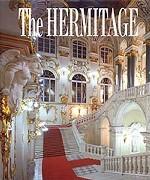There are few museums in the world of the Hermitage range, and even among them the Hermitage stands out thanks to its exclusive features. Different physical and spiritual spaces cross in the Hermitage, strikingly and sometimes unexpectedly. The metamorphoses occurring with them open up endless images of the artistic universe of the Hermitage. Common notions of dimensions, relationships and movements are not always valid for these spaces. The Hermitage occupies nine buildings today. However, there are more of them in reality. The Winter Palace of Peter the Great, which is situated within the Hermitage Theatre, under its stage, might well be added to them. Another building to be taken into account is the Stock Repository located in the area of Staraya Derevnya, if only half-completed now...
The museum has several symbols. The two principal ones are the Portico with Atlantes at the New Hermitage and the Main Gate of the Winter Palace. The right to typify the Hermitage is challenged by the facades of the museum buildings stretching alongside the Neva. They are marked by an architectural spatial rhythm - majestic and continuous, in contrast with the broken rhythm traceable in the outlines of the islands, the banks of the canals and small rivers of the Neva delta, as well as in the silhouette of the Peter and Paul Fortress on the opposite bank. During the several recent years Palace Square with the Alexander Column and the Triumphal Arch has also become the Hermitage`s emblem of a sort. The handing over to the museum of the eastern wing of the General Staff building has enlarged the direction of the museum`s cultural expansion, creating a new vector of movement. The horizontal of the Baroque facades of the Winter Palace and the Classical semi-circle of the General Staff make up a dynamic spatial spring. It directs the visitor from the Triumphal Arch across Palace Square, through the Main Gate and the Large Courtyard to the rooms of the Hermitage. It seems to me that this movement symbolizes the incessant advance of the museum itself, constantly changing, overcoming trials and tribulations, but never losing its fundamental traditions. All the wonderful buildings from which the Hermitage consists are not very large. This makes the interiors of the Hermitage palaces even more overwhelming for the visitor. The architecture of the Hermitage buildings itself is one of the museum`s highlights - an elegant and edifying "exhibit".
The art book I am introducing by this foreword presents to the reader for the first time a special view of the interior spaces of the Hermitage. The photographers and designers have succeeded in capturing an essential part of the impression evoked by the museum`s rooms and halls. The unique spaces of the Hermitage have several dimensions: architectural artistic, museum proper and historical ones. The walls of the Hermitage remember a great number of crucial events in Russian history. Peter the Great died here, Catherine the Great lived and collected paintings within these walls. Alexander I, the future victor over Napoleon Bonaparte, came to live here after the assassination of his father, Paul I. Nicolas I went to suppress the uprising in December 1825 from this place. He supervised a struggle with a devastating fire in the Winter Palace and created an art museum - the New Hermitage. Stepan Khalturin exploded a bomb under the royal dining-room here, and Tsar-Liberator Alexander II was brought to die here after an explosion of another bomb. Nicholas II opened the first Russian Parliament - the State Duma - in the Winter Palace. The Provisional Government had its sessions in the same palace and was arrested in it after the October Revolution. A peaceful demonstration was shot in front of the Winter Palace in 1905. The palace was assaulted in 1917 by those who got tired of their former life. The Hermitage which witnessed all these historic events, lived through three evacuations - one in connection with Napoleon`s invasion in 1812, and two others during the First and Second World Wars. The buildings of the museum saw several revolutions. The Hermitage was a symbol of the spiritual endurance during the terrible siege in the years of the Second World War, and has become an epitome of beauty resisting evil.


